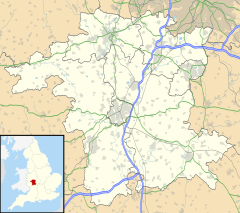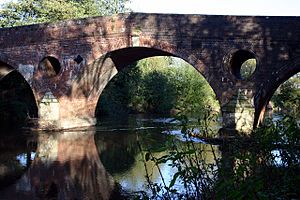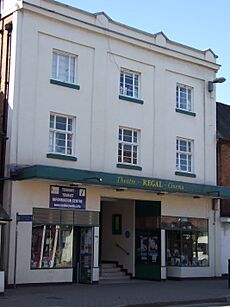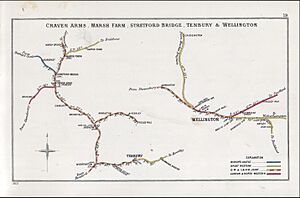Tenbury Wells facts for kids
Quick facts for kids Tenbury Wells |
|
|---|---|
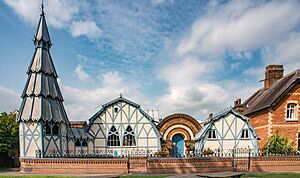 The Tenbury Wells Pump Rooms |
|
| Population | 3,777 (2011) |
| OS grid reference | SO595676 |
| Civil parish |
|
| District |
|
| Shire county | |
| Region | |
| Country | England |
| Sovereign state | United Kingdom |
| Post town | TENBURY WELLS |
| Postcode district | WR15 |
| Dialling code | 01584 |
| Police | West Mercia |
| Fire | Hereford and Worcester |
| Ambulance | West Midlands |
| EU Parliament | West Midlands |
| UK Parliament |
|
Tenbury Wells, often called Tenbury by locals, is a lively market town in Worcestershire, England. It's located in the far northwest of the Malvern Hills District. The town sits right next to Shropshire. In 2021, Tenbury Wells and nearby Burford together had a population of 5,224 people.
Contents
A Journey Through Tenbury Wells' History
The story of Tenbury Wells goes way back to the Iron Age. There's a place called Castle Tump nearby. It might be the remains of an old Norman castle. This castle was built to protect a crossing point on the River Teme.
The town was first called Temettebury. In 1249, it was given a special permission to hold a market. Over time, its name changed to Tenbury. The word Wells was added later, in the 1840s. This happened after people found special mineral water springs in the town.
When the railways arrived in 1864, it was a big deal! The town celebrated with parties and a carnival. The local train station even changed its name to Tenbury Wells in 1912. This was to help promote the mineral water from the wells.
For over 100 years, Tenbury has been famous for its winter auctions. People come from all over to buy holly and mistletoe for Christmas. The town is also known for its unique Pump Room buildings. They were built in 1862 and look a bit like Chinese buildings. They were restored in 2001 and are now owned by the town council.
Kyrewood Priory: A Small Monastery
Kyrewood Priory was a small religious house built in the 1200s. It was home to a group of Augustinian nuns. They dedicated their lives to St. Mary Magdalene.
Not much is known about the priory's daily life. It was likely founded around 1238 by a noblewoman named Margery de Sapy. The priory was quite small, with only a few nuns living there. Local landowners helped support it financially.
Even though it was small, Kyrewood Priory was known for its good deeds. It received donations of land and money over the years. However, by the 1500s, it was falling apart. In 1536, King Henry VIII closed down many monasteries, including Kyrewood Priory. Its land and buildings were then sold. Today, only small pieces of stone remain from the priory.
Amazing Buildings in Tenbury Wells
One special building is the Pump Rooms. They have a unique Chinese-Gothic style. James Cranston designed them in the 1860s. They were built to house baths where people could use the mineral water.
Another important building is the parish church of St Mary. It has a Norman tower and many old monuments. The church was mostly rebuilt between 1864 and 1865.
The bridge over the River Teme connects Tenbury to Burford. Part of it is from the medieval period. It was rebuilt by Thomas Telford in 1795 after a flood. Sadly, the Grade II-listed Eastham bridge collapsed into the River Teme in 2016. Luckily, no one was hurt.
The old Victorian workhouse was designed by George Wilkinson. It was used by the local council for many years. Now, it's being turned into homes. The old infirmary behind it was taken down to make space for a new supermarket.
Tenbury Wells' Location and Floods
Tenbury Wells is located on the south side of the River Teme. The river forms the border between Shropshire and Worcestershire. The town of Burford is on the north side of the river.
Dealing with Flooding
Tenbury has often experienced floods over the centuries. Recent floods happened in 2007, 2008, 2020, and 2024.
- The 2007 flood was caused by the River Teme and Kyre Brook overflowing.
- In 2008, heavy rain and blocked drains led to a flash flood.
- The 2020 flood also involved the River Teme and Kyre Brook.
- In November 2024, Storm Bert caused more flooding. The town center flooded quickly after the Kyre Brook rose and a wall fell down.
People are now wondering if Tenbury Wells could be the first UK town center to be abandoned because of climate change.
How Tenbury Wells is Governed
From 1894 to 1974, Tenbury was a rural district. It included the town and nearby villages like Stoke Bliss and Eastham. Since 1974, Tenbury has been part of the Malvern Hills District.
Fun Things and Local Interests
The Regal Cinema
The Regal Cinema in Tenbury Wells opened in 1937. It showed movies until 1966. To save it from being torn down, the town council bought it. Now, volunteers help run it.
The Regal has been beautifully restored. It has copies of its original 1930s paintings inside. The front of the building also looks like it did in the 1930s. The cinema is now managed by a trust. It shows new films, live events, and even live performances.
Apple and Fruit Heritage
Tenbury was once known as "the town in the orchard." This is because there were many fruit orchards nearby. They grew apples, pears, quinces, and plums. Every October, the town celebrates this history with the Tenbury Applefest.
Local Markets
Until 2018, markets were held on Tuesdays, Fridays, and Saturdays. They took place in and around the town's Round Market building. This building was built in 1858.
Power Station Plans Stopped
There was a plan to build a biomass power station in Tenbury. But residents were worried about the noise and disruption. Many people signed a petition against the plans. In 2009, the grant for the power station was taken away, and the project was stopped.
Learning in Tenbury Wells
For younger students, Tenbury CofE Primary School serves the town. Tenbury High Ormiston Academy is the main secondary school for the area. The private boarding school, King's St Michael's College, closed in 2020.
Getting Around Tenbury Wells
The old Tenbury Wells railway station served the town from 1861 to 1962. It was on the Tenbury Railway.
Today, the closest train stations are at Ludlow and Leominster. These stations are on the Welsh Marches Line. Transport for Wales runs regular trains on this line.
Bus services are also available. They connect Tenbury Wells to places like Bewdley, Kidderminster, Ludlow, and Worcester.
Media and News
Television
Local news for Tenbury Wells comes from BBC West Midlands and ITV Central. You can get TV signals from the Sutton Coldfield transmitter.
Radio
There are several local radio stations you can listen to:
- BBC Hereford and Worcester
- Heart West Midlands
- Smooth West Midlands
- Radio Wyvern
- Capital Mid-Counties
- Greatest Hits Radio Herefordshire & Worcestershire
- Hits Radio Herefordshire & Worcestershire
- Carousel FM, a local community station.
Newspapers
Local newspapers that cover Tenbury Wells include:
- Hereford Times
- Shropshire Star
- Ludlow Advertiser
- Teme Valley Times
- Tenbury Wells Advertiser
Famous People from Tenbury Wells
- Acton Adams (1843–1924), a politician from New Zealand, was born near Tenbury.
- Sir Archer Baldwin MP died in Tenbury in 1966.
- Dean Vincent Carter, an author.
- Thomas Goode (1835–1926), a farming pioneer in South Australia, was born near Tenbury.
- Ian Griggs, who later became Bishop of Ludlow, worked as a priest in Tenbury from 1984–87.
- Henry Hill Hickman, a pioneer in anaesthesia, worked as a surgeon in Tenbury.
- Jason King, a DJ and TV presenter, was born in Tenbury.
- Frederick Ouseley, a composer and musician, founded St Michael's College.
- Wilfred Shorting, a cricketer, was born in Tenbury.
Images for kids
See also
 In Spanish: Tenbury Wells para niños
In Spanish: Tenbury Wells para niños


